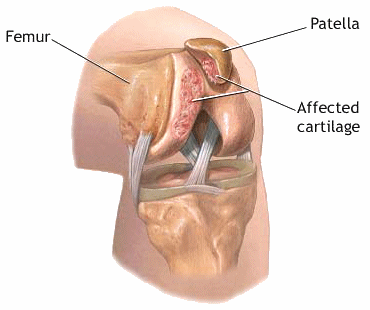Patellofemoral syndrome - pain, symptoms and treatment

Patellofemoral syndrome is Pain at or around the patella (kneecap) that often is worse when walking or running downhill or going down steps. Many people also experience the same kind of pain when sitting with the knees bent for a prolonged time. Doctors believe patellofemoral syndrome results from a combination of factors that include anatomy (individual variations in the structure of the knee), biomechanics (the function of the knee), and the kinds of activities the person conducts.
The more inactive an individual is, the more likely he or she is to develop patellofemoral syndrome. However, most doctors do not believe this condition is one of overuse. Some experts believe an imbalance of STRENGTH among the four parts of the quadriceps permits dysfunctional tracking of the patella, contributing to the syndrome. Most athletic activities that use the quadriceps, such as running and bicycling, strengthen the lateral (outer) muscles more than the medial, pulling the patella off track.
Symptoms of Patellofemoral Syndrome and Diagnostic Path
The main symptom of patellofemoral syndrome is PAIN going down steps or downhill and when sitting for long periods of time with the knees bent (flexed). The characteristic and specific nature of these symptoms allow the doctor to make a straightforward clinical diagnosis. X-rays and other diagnostic imaging procedures are not necessary unless there is reason to suspect another reason for the symptoms.
Patellofemoral Syndrome Treatment Options and Outlook
Treatment often combines one of the NONSTEROIDAL ANTI-INFLAMMATORY DRUGS (NSAIDS) to relieve INFLAMMATION and pain with PHYSICAL THERAPY to strengthen the quadriceps, particularly the medial (inner) muscles of this group. Most people experience relief from this treatment approach within two weeks and can return to their regular activities, including most sports, in four to six weeks.
Patellofemoral syndrome - Risk Factors and Preventive Measures
Women, particularly those in their late teens and early 20s who are inactive, are more likely than men to develop patellofemoral syndrome. Researchers do not know why this is. Exercises to maintain balanced strength in the quadriceps MUSCLE appears to prevent further occurrences of symptoms. A soft knee brace that holds the patella in position may also help maintain proper tracking of the patella. Some athletic trainers advocate wrapping or taping the knee before participation in an athletic event, which accomplishes a similar purpose.
See also KNEE INJURIES.
Open discussion on the topic Patellofemoral syndrome - pain, symptoms and treatment
Similar interests
- Casino Non Aams
- Nuovi Casino
- Casinos Not On Gamstop
- UK Casinos Not On Gamstop
- Casinos Not On Gamstop
- UK Casinos Not On Gamstop
- Casino Non Aams Italia
- Slot Sites Not On Gamstop
- Meilleur Casino En Ligne
- Non Gamstop Casino Sites UK
- Meilleur Casino En Ligne
- Casino En Ligne France
- Best Non Gamstop Casinos
- Casinos Not On Gamstop
- UK Casino Not On Gamstop
- Casinos Not Signed Up To Gamstop
- Best Slot Sites UK
- Non Gamstop Casino Sites UK
- Online Casinos Nederland
- Online Casinos Nederland
- Casinos Not On Gamstop
- Best New Uk Casinos Not On Gamstop
- Casino Non Aams
- Non Gamstop Casinos UK
- Migliori Siti Casino Non Aams
- Bitcoin Casinos
- Sites De Paris Sportifs Belgique
- Bookmaker Non Aams
- Casino En Ligne
- Casino Français Sans Kyc
- Casino Nouveau En Ligne